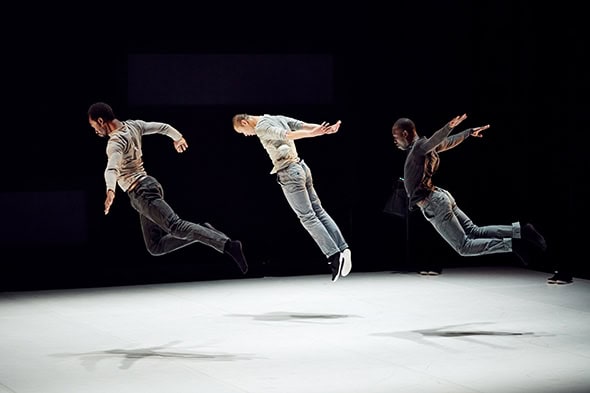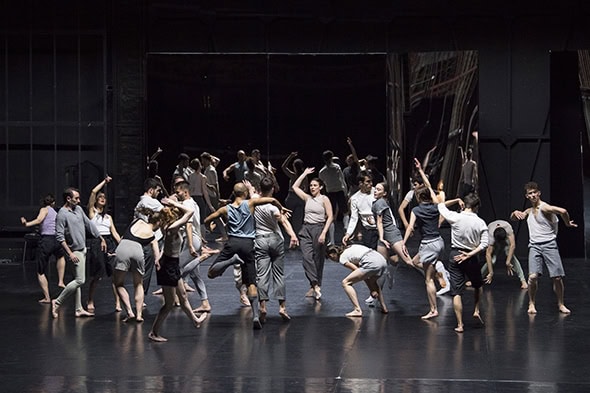Dance Umbrella 2019: The Future Bursts In at the Linbury Theatre
Posted: November 10th, 2019 | Author: Nicholas Minns & Caterina Albano | Filed under: Festival, Performance | Tags: Alexander Bland, Amala Dianor, Awir Leon, CCN Ballet de Lorraine, John Cage, Mark Lancaster, Meg Harper, Merce Cunningham, Pansum Lin, Petter Jacobsson, Souleyman Ladji Koné, Thomas Caley, Vanessa Wagner | Comments Off on Dance Umbrella 2019: The Future Bursts In at the Linbury TheatreDance Umbrella 2019, The Future Bursts In, The Linbury Theatre, October 25

The title of this Dance Umbrella evening at the Linbury Theatre, The Future Bursts In, is adapted from Alexander Bland’s Observer review of Merce Cunningham’s first performance in London in 1964. He wrote, ‘Merce Cunningham and his company have burst on the British scene like a bomb…Here is heart-warming proof that it is an art with a future, opening up ranges of possibilities which stretch out of sight; it ought to be celebrated with champagne in every dancing academy in the land.’
Over fifty years later neither Cunningham nor his musical collaborator and life partner, John Cage, are still with us, but their legacy continues through the Merce Cunningham Trust. It is not only Cunningham’s works but the technique he developed and taught that are revered for the very reasons Bland identified. But history moves on and the future continues to burst in, not necessarily through a single figure or a monolithic technique but with fresh approaches to dance practice and to training.
Amala Dianor is a Senegalese dancer currently based in Angers. Somewhere in the Middle of Infinity, is a beautifully crafted trio for performers whose techniques are grounded in hip hop but borrow from classical and contemporary dance. Theirs is a collaborative venture in which the three dancers — Dianor, Pansum Kin and Souleyman Ladji Koné — have come together to make a conversation of their diverse techniques. After calmly taking stock of the audience, they turn their focus inward, gently teasing out each other’s ability, admonishing each other and competing with each other’s vocabulary; it’s as if we are watching them through a window. We see their silent gestures and feel their choreographic affinity; we hear the tracks they choose from a score by Awir Leon but the music is for their own delectation, not ours. The pleasure is in seeing their ability to find effortless equilibrium and poise in their shared virtuosity. It is not so much the future bursting in as the dance diaspora reuniting with vestiges of the past to enhance the present.
Celebrating Cunningham’s legacy involves the more ticklish problem of looking back without the living presence of the man himself, who died in 2009. CCN Ballet de Lorraine presents two works to mark the centenary of Cunningham’s birth, a new commission by Petter Jacobsson and Thomas Caley, For Four Walls, based on a lost work of 1944, and a recreation of Sounddance from 1975. Jacobsson is the artistic director of CCN Ballet de Lorraine and Caley is its coordinator of research; both men worked closely with Cunningham as dancers in the 90s.

All that still exists of Cunningham’s Four Walls — it had only one performance — is the piano score by John Cage, played here on stage by Vanessa Wagner. Jacobsson writes that ‘we choreographed For Four Walls not as a re-enactment of the original, but as a place that allows for our history with Cunningham to be reflected in it.’ The idea of reflection becomes an opening conceit as we see nine dancers transformed into a full company by floor-to-ceiling mirrored panels. When the full contingent of 23 dancers subsequently fills the stage, swelling the ensemble to the size of an opera chorus in a crowded studio, the conceit loses its effect. As an exercise in spatial awareness and choreographic prestidigitation, it is awe-inspiring but any sense of reflection on ‘our history with Cunningham’ is effectively curbed.
After a short pause in which we watch the mirrors — and our own reflection in them — disappear behind the stage to be replaced by Mark Lancaster’s delightful flourish of a curtain with its tent-like opening, ten of the dancers return for Sounddance. Despite the pedigree of recreation by Meg Harper (from the original cast) and Thomas Caley, some of the classical rigidity Cunningham had encountered at the Paris Opera in 1975 and wanted to jettison in the creation of Sounddance seems to have crept in, either from the dancers’ exhaustion or a technical legacy of upper-body tension; they seem to be doing the movement rather than letting it happen, while entrances and exits are more circumspect than explosive.
In the same review, Bland imagined Diaghilev would have loved Cunningham for ‘talking in the language of today’. But what does ‘the language of today’ mean in a performance archive that is 44 years old? And wasn’t this the question Cunningham wanted to pre-empt as part of his legacy by planning the closure of his company and school after his death?